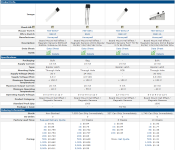Oakwright
10 mW
So, my halls are dead. They are SS41F, and I figured for simplicity I would replace it with the same sensors. However, it apparently is rather hard to find SS41F. No one has them in stock (I checked Digi-Key, Mouser, and about two dozen other places). Digi-Key told me it would be an 8 week wait and 1000 min order, and Mouser hasn't gotten back to me on how long the wait will be.
So, I'm wondering if maybe I could use a different sensor. How interchangeable are these things? How much difference is there between each of the SS41 series?
So, I'm wondering if maybe I could use a different sensor. How interchangeable are these things? How much difference is there between each of the SS41 series?




